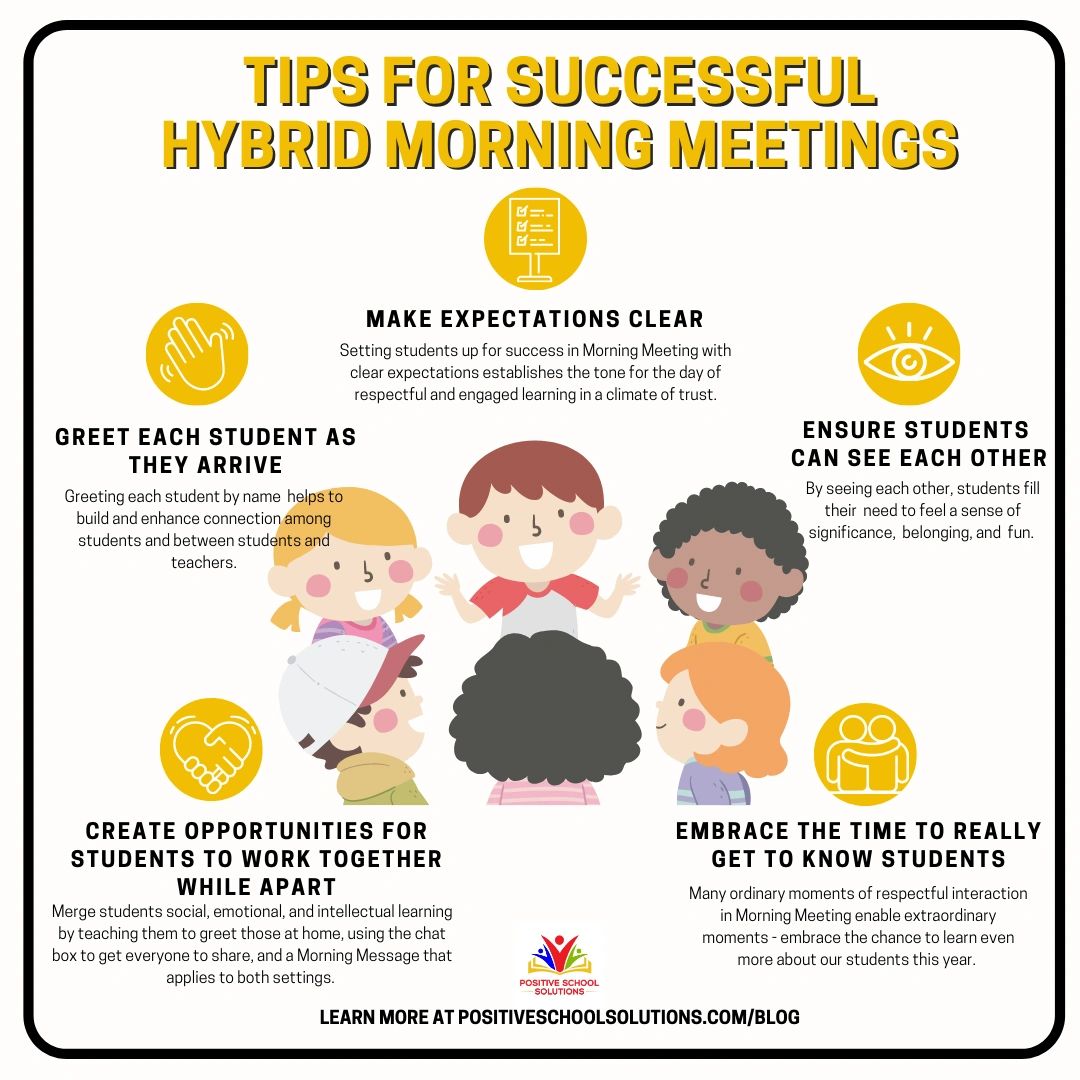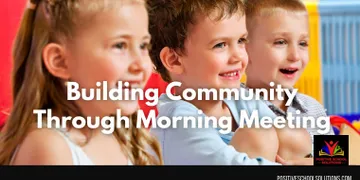According to “The Morning Meeting Book” by Roxanne Kriete & Carol Davis, “Teachers have long known, and researchers are now confirming that social skills are not just something to be taught so that children behave well enough to get on with the real business of schooling. Rather they are inextricably intertwined with cognitive growth and intellectual progress.” Morning Meeting is one of the many ways that we build these skills and relationships and establish the tone of our classrooms. This year, as we have been transitioning from in-person to remote learning to hybrid learning repeatedly, Morning Meeting continues to be the time of consistency and predictability that our students crave.
As many schools have transitioned back into a hybrid model this month, teachers and school leaders are seeking suggestions on how to set up Morning Meetings for continued success when half the students participate in person and the other half virtually. Our answer to this is relatively simple – head back to the purposes/goals of Morning Meeting. When keeping these at the forefront, we ensure we are staying true to the structure of what makes Morning Meeting so powerful. Let’s take a look at each of the purposes from “The Morning Meeting Book” to see how we can bring them to life in our hybrid learning environments so all students feel part of the community, regardless of location.

Morning Meeting sets the tone for respectful and engaged learning in a climate of trust.
Just as when we were teaching classrooms full of students, setting the tone and climate with clear expectations is going to help us not only during Morning Meeting, but throughout our school day. This might mean that even if you have been doing an online meeting all year, you might need to pull back when transitioning to hybrid learning. Model for students what happens during each component in a hybrid Morning Meeting, introducing and practicing only one component at a time until they feel confident and comfortable with the expectations. Establishing expectations and linking them to your classroom rules is key in setting everyone up for success.
Builds and enhances connections among students and between students and teachers.
When we start the day as a class, with everyone together, we set the tone that every person matters. When our classes are split, some on screen and some in person, one way we can maintain a positive tone is to make sure that each student receives a personal greeting when they arrive. This might be a greeting at the door by the teacher or a ‘Good Morning, (name)’ when they enter Zoom. It could also be a student’s role to greet the online students while admitting others from the waiting room. (For more on student roles, see post link here.)
Morning Meeting merges academic, social, and emotional learning.
Morning Meeting is a time where we create opportunities for students to work together while they are apart – either socially distanced in the classroom or with in-person and remote learners. One way we can do this is through Morning Message/Announcements. During this component, consider having two sections to your message – one for online learners and one for in person learners. For example, “You’ll need these materials to continue if you are working remotely” vs “As we head back to our seats, we will take out our math workbooks” for in person learners. Carefully consider how you’ll have students engage with the content so that students who are at home are also able to participate in reading the message and getting ready for the day.
Morning Meeting motivates students by addressing the human need to feel a sense of significance and belonging, and to have fun.
Morning Meeting is full of opportunities for our students to feel a sense of belonging and significance – and especially right now – this is something they are seeking more than ever. It is important to help students in split classrooms meet these needs by making sure they can see one another. One way to do this is to gather in person students on a rug and project the virtual students on the board so all can be seen and acknowledged.
Then, consider using greetings that have students in the classroom stand and greet someone on Zoom, and then that student can in turn greet a student back in the classroom. At a break time during the day, you might partner in-class students with at-home students in break out rooms to come up with a virtual “handshake” they can do the following day on their turn.
During the sharing component, encourage students at home to ask questions/make comments through the chat box so they remain active and engaged.
And during the activity component, choose activities that allow students in both groups to participate – a song, Go Noodle, or a “This or That” activity are all fun and simple ways to get students up and moving together!
Through repetition of many ordinary moments of respectful interaction, Morning Meeting enables some extraordinary moments.
During such uncertain times for our students, experiencing the four consecutive pieces of Morning Meeting each day can be a time of safety and comfort. This can lead to students forming even stronger bonds and relationships. Think about it – you likely know more about your students this year than ever before because we are in their homes and seeing (and hearing) their families/caregivers on a daily basis. Instead of running from it, embrace it: allow the student at home to share their pet, meet someone’s younger sibling, have them count the number of books on their bookshelf. All of these actions allow our students to make connections with one another, and with us, in ways we have never been able to do so before. In addition to leading to stronger relationships, we gain more information about how to best support our learners both in and out of the classroom.
In this unique school year, the power of Morning Meeting is clear. “Alfred Adler (1930) proposed that a sense of belonging motivates children to develop their skills and contribute to the welfare of all… Research indicates that educators who establish firm boundaries, foster warm personal relationships in the classroom, and enable students to have an impact on their environment strengthens students’ attachment to their school, their interest in their learning, their ability to refrain from self-destructive behaviors, and their positive behaviors.” (Elias et. al 1997, 44) Morning Meeting provides the structure to do all this and more in the first 20 minutes of our day – what a powerful opportunity!
For more on how to set up and run morning meetings with your students, check out our online courses: Building Community Through Morning Meeting, or reach out to us for professional development opportunities and coaching, and be sure to follow us on social media for more tips and tricks!
Written by Dana Januszka & Sarah Fillion for Positive School Solution 2021


